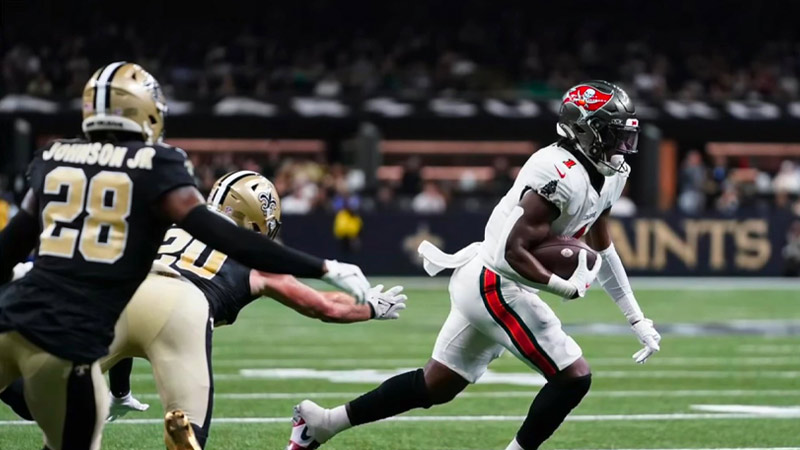American football is a thrilling sport defined by its strategic complexity. One of its core elements is the running play, a fundamental strategy that can change the course of a game.
Our comprehensive exploration will dissect the intricacies of American football running plays. These plays form the backbone of an offensive playbook, offering various variations, tactics, and challenges.
We’ll explore the strategies behind inside runs, sweeps, counters, and option plays. You’ll gain insights into the critical pre-snap reads, offensive formations, and defensive responses that shape each play.
From creating ball control and misdirection to setting up explosive play-action passes, running plays are the building blocks of victory on the gridiron.
Whether you’re a die-hard football enthusiast or a newcomer to the sport, understanding these plays will deepen your appreciation for the game’s brilliance. Stay focused.
What Is Football Running Play?
A football running play, often called a “rush” or “run,” is a fundamental offensive strategy in American football.
It involves the quarterback handing the ball to a running back, who then attempts to carry it forward by running through gaps in the opposing team’s defense. The primary objective is to gain yardage and advance the ball closer to the opposing team’s end zone.
Running plays are crucial for balancing an offensive strategy and can help control the clock, tire out the opposing defense, and open up passing opportunities.
Various types of running plays exist, including sweeps, draws, traps, and power runs, each with its unique blocking schemes and tactics.
Successfully executing running plays requires skilled running backs, a strong offensive line, and effective play-calling.
10 Types of Running Plays in American Football
In American football, various types of running plays are designed to exploit different aspects of the defense and gain yardage. Here are some common types:
1. Dive (Inside Run)
This is a straightforward play where the running back takes the ball and heads directly between the offensive tackles, aiming for a quick gain up the middle.
2. Power Run
In a power run, the offensive linemen block in a way that creates a hole for the running back to burst through. It often involves a pulling guard or fullback to lead the way.
3. Counter Run
The counter run is a misdirection play. It starts in one direction, causing the defense to flow that way, and then the running back changes direction to exploit the openings on the other side.
4. Sweep (Outside Run)
In a sweep, the running back moves parallel to the line of scrimmage before heading toward the sideline. The offensive linemen pull and block to the outside to create running lanes.
5. Draw Play
This is a deceptive play where the quarterback drops back as if to pass and then hands off the ball to the running back, who follows blockers up the middle.
6. Zone Run
In a zone run, the offensive linemen block an area rather than specific defenders. The running back reads the blocks and chooses the best running lane.
7. Pitch Play
Depending on the defense, the quarterback tosses the ball to the running back, who can run inside or outside.
8. Option Run
Depending on the defensive read, the quarterback can either hand off to the running back or keep the ball and run themselves.
9. Stretch Run
It’s similar to a sweep, but the running back takes a wider path to the sideline, trying to stretch the defense horizontally before finding a crease.
10. Wildcat Formation
In this unconventional formation, a non-quarterback player often takes the snap and can run, pass, or hand off the ball, adding an element of surprise to running plays.
These are just some of the many running play variations in American football.
Importance of Running Plays in American Football Strategy
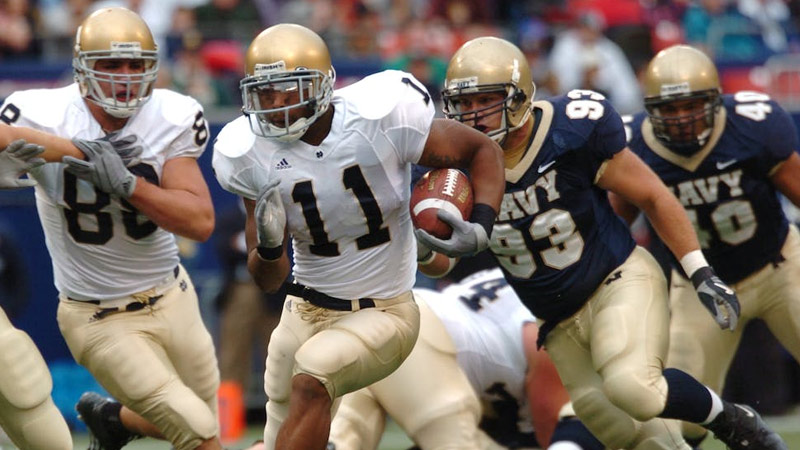
Running plays a crucial role in American football strategy, offering several advantages and key elements to a team’s offensive game plan:
Ball Control and Clock Management
Running plays are essential for controlling the time of possession. When teams effectively run the ball, they keep the clock moving, limiting the opposing team’s opportunities to score.
This strategy is particularly valuable when holding and trying to preserve a lead.
Wear Down the Defense
Running plays can physically wear down the opposing defense. Constantly pounding the ball forces defenders to make tackles and expend energy, which can lead to fatigue and a weaker defense as the game progresses.
Balance and Play-Action
Establishing a successful running game creates balance in the offense. This, in turn, sets up play-action passes, where the quarterback fakes a handoff before attempting a pass.
The threat of a strong running game can draw defenders close to the line of scrimmage, creating opportunities for deep passes.
Short Yardage and Goal-Line Situations
Running plays are highly effective in short-yardage situations and near the goal line.
A powerful running back and offensive line can gain the necessary yardage for first downs and touchdowns, improving a team’s overall red zone efficiency.
Keep the Defense Honest
The threat of a running play keeps the defense honest. If the defense is too focused on stopping the pass, a well-executed running play can exploit the gaps in the line of scrimmage.
Managing Field Position
Running plays can help with field position. A successful running play can move the ball out of a team’s territory, making it easier to punt and pin the opponent deep in their territory or even set up a field goal attempt.
Minimize Turnovers
Passing plays, especially deep throws, carry a higher risk of turnovers. Running plays are generally safer regarding ball security, reducing the chances of interceptions or fumbles.
Running plays are a fundamental component of American football strategy. They offer advantages regarding clock management, physicality, and balance and can create opportunities for big plays through play-action passes.
Pre-Snap Read and Formation of Running Plays in American Football
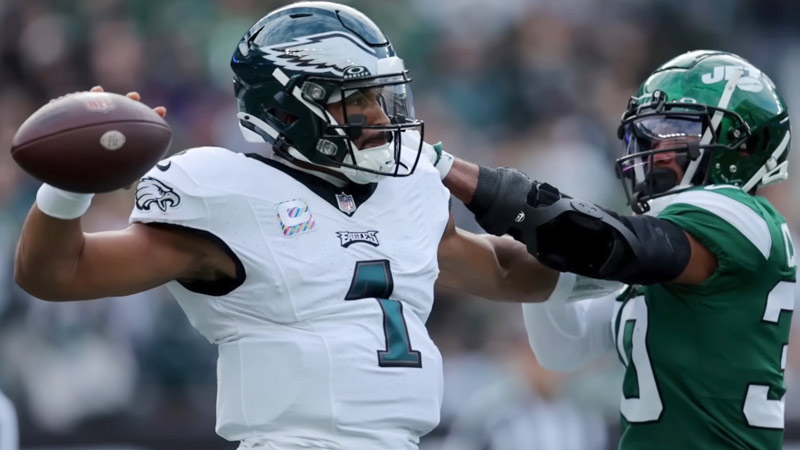
Pre-snap reads and formations are critical aspects of executing running plays in American football. Here’s how they work:
Pre-Snap Read
Check below to know about Pre-snap read;
Identifying Defensive Front
Before the snap, the quarterback or running back may read the defensive front. This includes determining the number of defensive linemen and linebackers and their alignment.
Defensive Gaps
The ball carrier must identify potential running lanes or gaps between defensive players.
These gaps are often labeled as “A” (between the center and guards), “B” (between guards and tackles), “C” (between tackles and tight ends), and “D” (outside the tight ends).
Linebacker Positioning
The position and depth of linebackers are crucial pre-snap reads. Linebackers can signal the potential direction of the running play. If they’re stacked in one direction, it may indicate a potential opening in the opposite direction.
Safety Position
The positioning of safeties can also influence the running play. If safeties are closer to the line of scrimmage, it may indicate that the defense is prepared to stop the run.
Formation of Running Plays
Check below to learn about Formation of Running Plays;
Offensive Formation
The offensive formation determines the initial alignment of the offensive players, including the quarterback, running back, offensive linemen, and wide receivers. Common formations for running plays include the I-formation, Singleback, Shotgun, and Pistol.
Running Back Position
The running back’s alignment within the formation can signal the type of running play.
For example, if the running back lines up directly behind the quarterback, it may be a dive or inside run. If the running back lines up to the side, it might be a toss or sweep play.
Blocking Assignments
Offensive linemen and tight ends have specific blocking assignments based on the play call. These assignments dictate which defensive players they should engage and the direction in which they should drive them to create running lanes.
Motion and Shifts
Offensive teams often use motion or shifts before the snap to create confusion or mismatches within the defense. Wide receivers or tight ends may go in motion, forcing the defense to adjust and reveal its coverage or alignment intentions.
Audibles and Checks
If the quarterback identifies something unfavorable in the defense during the pre-snap read, they may change the play at the line of scrimmage. This could involve switching the running play to the opposite side or converting it to a pass play.
Snap and Execution
Once the snap occurs, the running back receives the ball from the quarterback and follows the designated blocking scheme and running lane.
The offensive linemen execute their blocking assignments to open up gaps, while the running backs use their vision, speed, and agility to exploit those gaps and advance the ball.
Pre-snap reads and offensive formations are integral to running plays in American football.
They help the offense make informed decisions, adapt to the defensive alignment, and create opportunities for the running back to gain yardage.
Strategies and Variations of American Football Running Plays
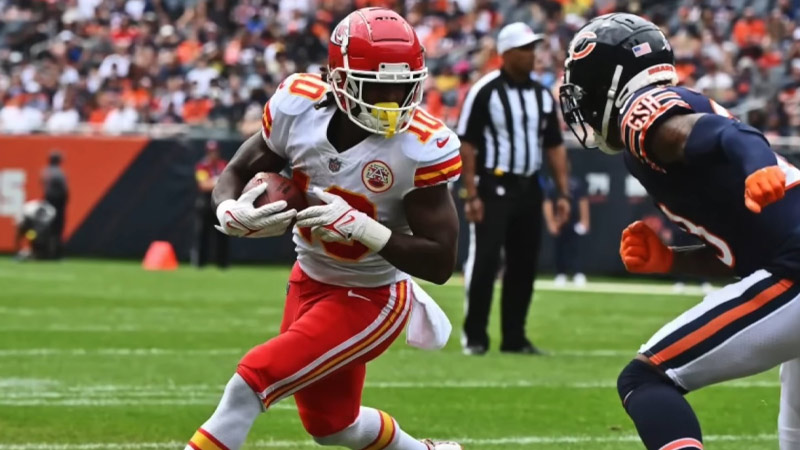
American football running plays involve various strategies and variations to outmaneuver the defense. Here are some common strategies and variations:
Inside Runs
- Dive/Inside Zone: The running back takes a direct handoff and aims to run between the offensive tackles. The offensive linemen block the defensive linemen and create a push up the middle.
- Power Run: This involves pulling a guard or fullback to lead the running back through a specific gap, often between the guard and tackle.
Outside Runs
- Sweeps/Toss: The running back moves parallel to the line of scrimmage before heading to the sideline. Offensive linemen pull and block to the outside to create running lanes.
- Stretch Run: Similar to a sweep, but the running back takes a wider path to the sideline, attempting to stretch the defense horizontally.
Misdirection and Counters
- Counter Run: The play initially moves in one direction, causing the defense to flow that way, and then the running back changes direction to exploit openings on the opposite side.
- Draw Play: This is a deceptive play where the quarterback drops back as if to pass before handing off to the running back, who follows blockers up the middle.
Option Plays
- Triple Option: Depending on the defense’s reaction, the quarterback can keep pitching to a trailing back or hand off to another back.
- Read Option: The quarterback reads a specific defensive player (often an end or linebacker) and decides whether to hand off to the running back or keep the ball.
Shotgun and Pistol Formations
These formations allow for quick-hitting running plays, such as the inside zone read, which gives the running back more space to make decisions and exploit gaps.
Play-Action Passes
Establishing a strong running game sets up play-action passes. The quarterback fakes a handoff to the running back before attempting a pass. This can catch the defense off guard.
Wildcat Formation
In this formation, a non-quarterback player often takes the snap and can run, pass, or hand off the ball, adding an element of surprise and unpredictability.
Singleback, I-Formation, and Splitback Sets
These formations vary the number of running backs and tight ends in the backfield, influencing the types of running plays that can be executed.
No-Huddle and Hurry-Up Offense
These strategies can keep the defense on its heels, limiting its ability to make substitutions and adjustments and allowing the offense to exploit favorable matchups.
Jet Sweeps and Reverses
Wide receivers or other players in motion take handoffs and run across the formation, trying to get to the edge or cut back for big gains.
These strategies and variations are used by offensive coordinators to keep the defense guessing, exploit weaknesses, and adapt to the specific strengths and weaknesses of their own team.
Challenges and Defensive Responses in Football Running Play
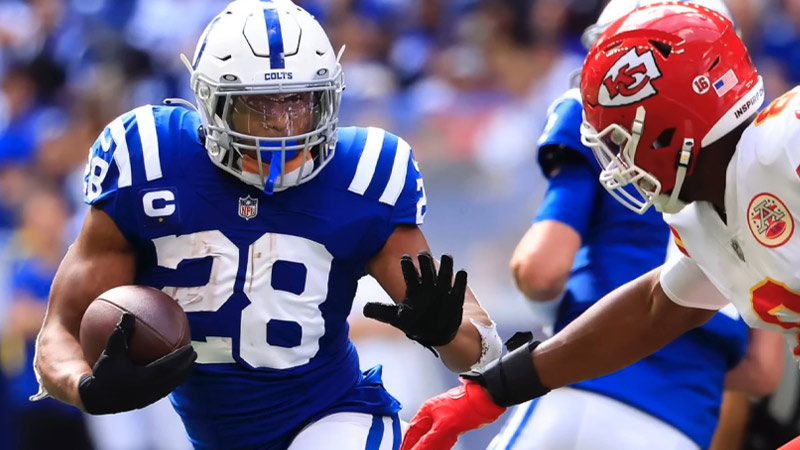
In American football, running plays pose challenges for the defense, and defensive teams must respond effectively to contain or stop them.
Here are some common challenges and defensive responses to football running plays:
Challenges
- Gap Control: Defenders must maintain gap integrity, ensuring they cover assigned gaps (A, B, C, D) and prevent running backs from exploiting openings.
- Play-Action: Strong running plays to set up effective play-action passes. Defenders must react quickly to play-action fakes without abandoning their run-defense responsibilities.
- Misdirection: Counter plays and misdirection can confuse defenders. They need to stay disciplined, read their keys, and not overcommit in one direction.
- Option Plays: Option plays require defenders to play assignment football. They must focus on specific offensive players and make quick decisions regarding who to tackle, pitch, or engage.
- No-Huddle Offense: Fast-paced, no-huddle offenses limit the defense’s ability to make substitutions and adjustments. Defenders must communicate and maintain proper alignment without the luxury of huddling.
- Blocking Schemes: Offensive linemen and tight ends execute various blocking schemes (zone, man, trap) that defenders must recognize and counter.
Defensive Responses
- Run Blitz: Defenses may send additional linebackers or defensive backs on a blitz to disrupt running plays in the backfield or force the running back to change direction.
- Stunts and Twists: Defensive linemen may use stunts and twists to confuse offensive linemen and disrupt blocking assignments.
- Run Support from Safeties: Safeties often play a key role in run support by filling run gaps or making tackles near the line of scrimmage.
- Linebacker Reads: Linebackers must read the offensive linemen’s movements and quickly diagnose the direction of the run, allowing them to shed blocks and make tackles.
- Maintain Gap Discipline: Defenders should avoid overcommitting or getting out of position. Staying disciplined in maintaining gap responsibilities is crucial.
- Edge Containment: Defensive ends and outside linebackers must set the edge to prevent running backs from bouncing outside. This containment forces the ball carrier back toward the interior of the defense.
- Defensive Line Penetration: Defensive linemen must work to penetrate the offensive line, disrupting blocking schemes and creating chaos in the backfield.
- Tackling Fundamentals: Good tackling techniques are vital in stopping running plays. Defenders must wrap up ball carriers and bring them to the ground efficiently.
- Zone Coverage: In pass-heavy formations or when anticipating play-action, defenders in zone coverage must remain disciplined and not abandon their zones to stop the run.
- Adjustments and Communication: Defenders must communicate with each other to make in-game adjustments based on the offense’s tendencies and the success of running plays.
Successfully responding to running plays involves a combination of sound fundamental techniques, intelligent reading of the offense, and effective communication among defenders.
FAQs
What is the primary objective of American football running plays?
The primary goal of running plays in American football is to advance the ball by handing it to a running back who carries it forward through gaps in the opposing defense, gaining yardage and moving closer to the opponent’s end zone.
How do pre-snap reads influence running play execution?
Pre-snap reads are crucial as they help the offense identify defensive alignments, potential gaps, and linebacker positioning.
This information guides the running back and offensive line in choosing the optimal running lane and blocking schemes for the play.
What are some common running play variations in American football?
Common running play variations include inside runs like dives and power plays, outside runs like sweeps and tosses, misdirection plays like counters and draws, and shotgun or pistol formations for quick-hitting runs.
Why are running plays important in a football team’s offensive strategy?
Running plays offer ball control, help manage the clock, keep the defense honest, create balance in the offense, and allow for effective play-action passes.
They are especially valuable in short-yardage and goal-line situations and contribute to field position.
How do defenses respond to American football running plays?
Defenses respond by maintaining gap discipline, using run blitzes or stunts to disrupt plays, providing run support from safeties and linebackers, and ensuring proper edge containment.
They must also communicate, read the offense, and adjust strategies based on the specific situation within the game.
Wrapping Up
In American football, running plays are not just about brute force but a symphony of strategy and execution.
From the classic power run up the middle to the mesmerizing misdirection of counterplays and option schemes, running plays embody the essence of the sport’s complexity.
As we conclude our journey through the world of American football running plays, we’ve unraveled the pre-snap reads, formation subtleties, and the intricate dance between offense and defense that defines each play.
These plays are more than just a means to advance the ball; they’re the strategic heartbeats of the game.
Whether you’re marveling at the precision of a quarterback’s handoff or the artistry of a running back weaving through defenders, running plays are where the magic happens on the gridiron. Thank you so much.

